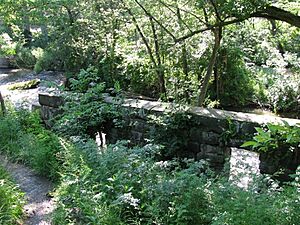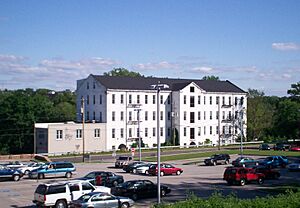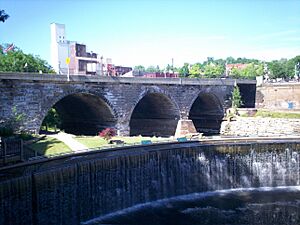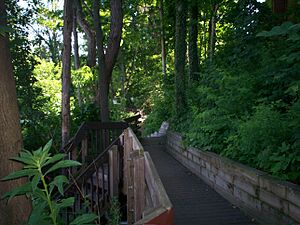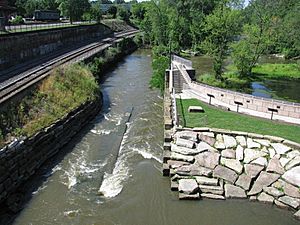Kent Industrial District facts for kids
Quick facts for kids |
|
|
Kent Industrial District
|
|
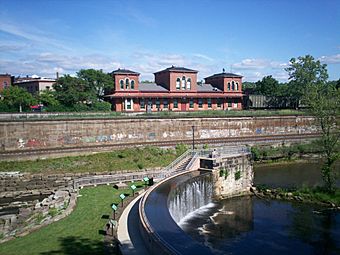
1875 Atlantic & Great Western Depot as seen from the Cuyahoga River
|
|
| Location | Downtown Kent, Ohio |
|---|---|
| Area | 4.3 acres (0.017 km2) |
| Built | 1851 |
| Architectural style | Italian Villa |
| NRHP reference No. | 74001603 |
| Added to NRHP | December 30, 1974 |
The Kent Industrial District is a special area in Kent, Ohio, United States, that is important for its history. It's listed on the National Register of Historic Places, which means it's recognized for its historical value.
This district covers about 4.3 acres in downtown Kent, right along the Cuyahoga River. It's generally located between West Main Street, River Street, Franklin Avenue, and Haymaker Parkway. Inside this area, you'll find three historic buildings and two old stone structures. The district was added to the National Register of Historic Places in 1974.
Marvin Kent, who the city of Kent is named after, played a big part in developing this area. It was very important for Kent's growth during the 1800s. Some of the oldest buildings here date back to the 1830s. The newest historic building, a livery and carriage shop, was built around 1910. Today, much of the district is part of the city's Franklin Mills Riveredge Park and Heritage Park, with some areas owned privately.
Contents
History of Kent's Industrial Area
Early Days and River Power
The area that is now the historic district was attractive to early settlers. This was because the Cuyahoga River could provide power for mills. John Haymaker, the first white settler in what became Kent, built the first gristmill (a mill for grinding grain) here in 1807. It was just north of where Stow Street is today.
More development began in the late 1830s. This was when the Pennsylvania and Ohio Canal was built. People hoped the village, then called Franklin Mills, would become a center for making silk. This led to a lot of land buying and building along the river. Many parts of downtown Kent were built during this time.
However, the "Panic of 1837" (a financial crisis) and the local climate not being good for silkworms ended the dream of a silk industry. But during this period, the first parts of today's historic district were built. A 19-foot stone arch dam and a lock for the canal were constructed in 1836. Zenas Kent, Marvin Kent's father, built a flour mill in 1837. He also built a tannery (a place for making leather) across the street. He ran the tannery with John Brown for a short time.
The Alpaca Mill Story
In 1851, Marvin Kent helped start the Franklin Mills Cotton Company. They began building a factory where an old silk mill had been planned but abandoned. The outside of the five-story building was finished by mid-1852. But then, the main investors left, and the company failed. The inside of the building remained unfinished for over 20 years.
In 1878, James Turner came from Jamestown, New York. He was looking for a new place for his alpaca mill. After making agreements with Marvin Kent, work began to finish the building. This included the inside and a new water wheel for power. The mill opened on September 4, 1879. It later started making worsted goods (a type of wool fabric). The mill operated for 10 years before moving to Cleveland in 1889.
Later, from 1914 to 1928, the building was used by the L.N. Gross Company. They made shirtwaists (a type of blouse) there. By 1928, the factory employed 150 women and girls. The company eventually built their own building nearby.
Railroads and Bridges
Marvin Kent also played a key role in bringing the Atlantic and Great Western Railroad to Franklin Mills. He helped make sure the town was a stop on the line. He also made sure the railroad's repair shops were located there. This led to railroad tracks being built through the eastern part of the historic district starting in 1853. A train station opened on June 1, 1875.
Soon after, in 1876, work began on a new Main Street bridge. The old one was a wooden covered bridge built in 1837. A new stone arch bridge was completed in 1877. In the 1880s, a second rail line was built through the district by the Baltimore and Ohio Railroad. These are known today as the "lower tracks."
Changes Over Time
After the alpaca-worsted mill left in 1889, the historic district became less important. In 1913, a big flood damaged the lock and dam. The damage was so bad that people debated whether to fix them or remove them. They were eventually repaired in 1925 because of their historical value.
The Kent flour mill and the Kent tannery (also called the John Brown tannery) were no longer used. The mill was torn down in the 1930s. The tannery lasted until 1976 when it was removed as part of an environmental cleanup. Also in the 1930s, land was given to the city to create Franklin Mills Riveredge Park. This park covers much of the historic district. Tannery Park is also located where the old tannery used to be. The park has a boardwalk along the Cuyahoga River. It follows the path of the old mill race, which was a channel that carried water from the dam to the mills.
Around 1910, a livery and carriage shop was built. This building later became a car dealership in the 1970s. Today, it holds several offices.
The Atlantic and Great Western Rail Depot, later called the Erie Depot, was used as a train station until 1970. It was then abandoned. In the early 1970s, it was almost torn down. But the Kent Historical Society, formed in 1971, saved it. They bought the building in 1975 and fixed it up. The society and the Kent Chamber of Commerce used the second floor until 2006. Just before the building was bought, the historic district was created. The depot was included and listed on the National Register of Historic Places in 1974. In 1981, the Pufferbelly Restaurant opened on the lower floor of the old depot and operated until 2017. Also in the early 1970s, Haymaker Parkway was built. Its main bridge forms the southern edge of the district.
In 2002, the old alpaca-worsted mill, known as the silk mill, was bought by a developer. It was renovated into apartments. Before that, it had been used as a warehouse. In 2004, the Ohio Environmental Protection Agency said the Cuyahoga River's water quality was too low. They suggested removing the dam. To balance environmental and historical concerns, one wall of the lock was removed. The channel was widened to let the river flow through. A small park called Heritage Park was built behind the dam. It includes a pump to send water over the dam during warmer months. It opened in May 2005. In 2017, Treno Ristorante opened in the space where the Pufferbelly Restaurant used to be.
Important Historic Structures
Here are the key structures that make up the Kent Industrial District:
- Stone arch dam and canal lock, built in 1836.
- Alpaca-worsted mill (also known as the Silk Mill), built in 1851.
- Atlantic and Great Western Rail Depot (also known as the Erie Depot), built in 1875.
- Main Street Bridge, built in 1877.
- Livery and carriage shop, built around 1910.




